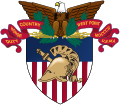
The United States Military Academy (USMA) is a United States service academy in West Point, New York. It was originally established as a fort, since it sits on strategic high ground overlooking the Hudson River 50 miles (80 km) north of New York City. It is the oldest of the five American service academies and educates cadets for commissioning into the United States Army.

The United States Air Force Academy (USAFA) is a United States service academy in El Paso County, Colorado, immediately north of Colorado Springs. It educates cadets for service in the officer corps of the United States Air Force and United States Space Force. It is the youngest of the five service academies, having graduated its first class 65 years ago in 1959, but is the third in seniority. Graduates of the academy's four-year program receive a Bachelor of Science degree and are commissioned as second lieutenants in the U.S. Air Force or U.S. Space Force. The academy is also one of the largest tourist attractions in Colorado, attracting approximately a million visitors each year.

The Royal Military College of Canada, abbreviated in English as RMC and in French as CMR, is a military academy and, since 1959, a degree-granting university of the Canadian Armed Forces. It was established in 1874 and conducted its first classes on June 1, 1876. The Government of Ontario empowered RMC to confer degrees in the Social Sciences and Humanities, Science, and Engineering through The Royal Military College of Canada Degrees Act, 1959. Programs are offered at the undergraduate and graduate levels, both on campus as well as through the college's distance learning programme via the Division of Continuing Studies.

The RMC Paladins are the athletic teams that represent Royal Military College of Canada in Kingston, Ontario, Canada. Its facilities include the Kingston Military Community Sport Centre (KMCSC) with seating for 3737, the Navy Bay fields with seating for 800 and Constantine Arena with seating for 1500 and the Birchall Pavilion.

Norwich University – The Military College of Vermont is a private senior military college in Northfield, Vermont. It is the oldest private and senior military college in the United States and offers bachelor's and master's degrees on-campus and online. The university was founded in 1819 in Norwich, Vermont, as the American Literary, Scientific and Military Academy. It is the oldest of six senior military colleges and is recognized by the United States Department of Defense as the "Birthplace of ROTC".

Canadian Forces Base Cold Lake, abbreviated as CFB Cold Lake, is a Canadian Forces Base in the City of Cold Lake, Alberta.
An obstacle course is a series of challenging physical obstacles an individual, team or animal must navigate, usually while being timed. Obstacle courses can include running, climbing, jumping, crawling, swimming, and balancing elements with the aim of testing speed, endurance and agility. Sometimes a course involves mental tests. The idea has been adapted into TV shows and video games.

The Sandhurst Military Skills Competition is a military skills competition at West Point that first began in 1967 with the presentation of a British officer's sword to the United States Corps of Cadets by the British Exchange Officer. 2010's event, dubbed SANCOM10, was a two-day event conducted at West Point, New York. The 2009 competition featured a record 49 teams and nearly 500 competitors. Besides the 36 squads from each of the West Point companies, visiting service academy teams included the Naval, Air Force and Coast Guard Academies, Britain's Royal Military Academy Sandhurst (RMAS) teams "Red" and "Blue", Australia's Royal Military College Duntroon, Canada's Royal Military College (RMC), the National Military Academy of Afghanistan, and the Chilean Military School. That year saw eight ROTC squads: Texas A&M, BYU, East Carolina University, Iowa State University, Florida Tech, Georgetown, University of Hawaii, and Appalachian State.

The International Life Saving Federation (ILS) is an organisation for drowning prevention, water safety, lifesaving and lifesaving sports.

The Army Black Knights football team, previously known as the Army Cadets, represents the United States Military Academy in college football. Army is a Division I Football Bowl Subdivision (FBS) member of the NCAA. The Black Knights play home games in Michie Stadium with a capacity of 38,000 at West Point, New York. The Black Knights are coached by Jeff Monken, who has held the position since 2014. Army claims three national championships from 1944 to 1946. In addition, major selectors have awarded Army championships in 1914 and 1916. Army has produced 24 players and four coaches in the College Football Hall of Fame, 37 consensus All-Americans, and three Heisman Trophy winners.

The National Military Academy of Afghanistan (NMAA) was one of three academic institutions of the Marshal Fahim National Defense University. It was a four-year military development institution dedicated to commissioning officers for the Afghan National Army (ANA) and the Afghan Air Force (AAF). The mission of the NMAA was to produce officers for the Afghan Armed Forces that also have a four-year college level bachelor's degree. The academy was based upon the United States Military Academy and United States Air Force Academy. After the fall of the Islamic Republic of Afghanistan on August 15, 2021, to the Taliban, and the simultaneous collapse of the Afghan National Army and Afghan Air Force the same day, the Academy was officially shut down.
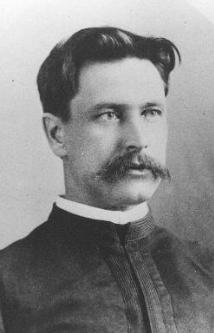
Herman John Koehler was an American football coach, athletics administrator, and United States Army officer. He served as the head football coach at the United States Military Academy from 1897 to 1900, compiling a record of 19–11–3.
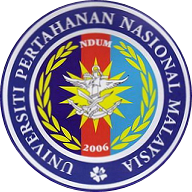
The National Defence University of Malaysia is a military university located in Sungai Besi Camp, Kuala Lumpur, Malaysia.
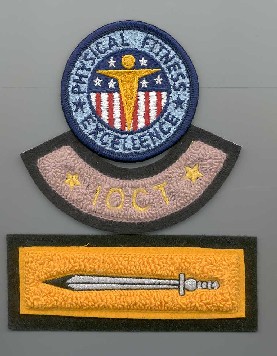
The Indoor Obstacle Course Test (IOCT) is a test of full-body functional physical fitness administered by the Department of Physical Education (DPE) at the United States Military Academy at West Point, New York. DPE considers the IOCT to be one of the best evaluations of total body fitness given in the Army. Cadets who earn an A− are authorized to wear the IOCT Badge on their athletic shorts.

The United States Military Academy and grounds were declared a National Historic Landmark in 1960 due to the Revolutionary War history and the age and historic significance of the academy itself. The majority of the buildings in the central cadet area are historic.
The history of the United States Military Academy can be traced to fortifications constructed on the West Point of the Hudson River during the American Revolutionary War in 1778. Following the war, President Thomas Jefferson signed legislation establishing the United States Military Academy (USMA) on the site in 1802. In 1817 the academy was transformed by the appointment of Sylvanus Thayer who drastically reformed the curriculum.
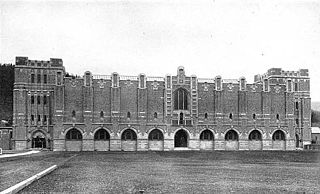
Hayes Gymnasium, completed in 1910, is the oldest section of the current Arvin Cadet Physical Development Center at the United States Military Academy. Originally built as an independent structure to replace the academy's previous Richard Morris Hunt-built gymnasium which had served between 1891 and 1910, it was part of a large contract bid awarded to the Boston architectural firm of Cram, Goodhue, & Ferguson in 1903.
The Master of the Sword, or MOSH, is the title of the head of the Department of Physical Education and the director of the program of physical instruction at the United States Military Academy at West Point. This position is unique in that the physical program at the academy is both academic and non-academic. Some of the courses are taught in a classroom or laboratory environment and some elements of the physical program are stand-alone testing and non-tested events that must be completed by all cadets during their time at the academy. The first Swordmaster was Pierre Thomas, appointed by Congress in 1814. There have been 27 Masters of the Sword since 1814. Despite its position as a department head since 1948, the Master of the Sword was not made a member of the Academic Board at West Point until 1974, with the appointment of Colonel James L. Anderson. The only woman to serve as MOS was COL Maureen LeBoeuf, serving 1997–2004. The current master of the sword, serving since 2015, is Colonel Nicholas Gist.

The Army Reserve Officer Training Corps (AROTC) is the United States Army component of the Reserve Officers' Training Corps. It is the largest Reserve Officer Training Corps (ROTC) program which is a group of college and university-based officer training programs for training commissioned officers for the United States Army and its reserves components: the Army Reserves and the Army National Guard. There are over 30,000 Army ROTC cadets enrolled in 274 ROTC programs at major universities throughout the United States. These schools are categorized as Military Colleges (MC), Military Junior Colleges (MJC) and Civilian Colleges (CC).

The Junior Reserve Officer Training Corps is a federal program sponsored by the United States Armed Forces in high schools and also in some middle schools across the United States and at US military bases across the world. The program was originally created as part of the National Defense Act of 1916 and later expanded under the 1964 ROTC Vitalization Act.

























